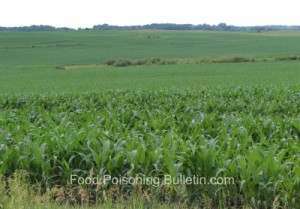Most people are surprised when a food poisoning outbreak is linked to leafy greens. Fresh vegetables are not the foods we think of in relation to foodborne illness. But the fact remains that leafy greens are the most common vector for delivering pathogenic bacteria to humans.
 Bacteria get onto leafy greens and other produce in several ways. They can be contaminated in the field by feces from birds and other animals. They can be contaminated in the field by poor worker hygiene. They can be contaminated in transport in dirty containers and trucks. They can be contaminated during processing if a facility doesn’t keep animals out, or if workers are sick. But there is one means of contamination that may be most troublesome: location of a farm field next to a cattle feedlot, as a study published in Applied and Environmental Microbiology showed.
Bacteria get onto leafy greens and other produce in several ways. They can be contaminated in the field by feces from birds and other animals. They can be contaminated in the field by poor worker hygiene. They can be contaminated in transport in dirty containers and trucks. They can be contaminated during processing if a facility doesn’t keep animals out, or if workers are sick. But there is one means of contamination that may be most troublesome: location of a farm field next to a cattle feedlot, as a study published in Applied and Environmental Microbiology showed.
Shiga toxin-producing E. coli bacteria occur naturally in ruminant animals such as cows. The animals do not get sick from this bacteria as humans do because we have different genes. The bacteria is excreted in feces and can find its way into ground water. When that ground water is used for irrigation, bacteria can be spread all over the crops.
But this study showed something else; the potential for airborne transmission of E. coli bacteria onto leafy greens fields. We know that bacteria can aerosolize and become airborne; that is why food safety experts tell consumers to never wash chickens or turkey before cooking them; this action can spread bacteria up to three feet away from the kitchen sink.
In the study, leafy greens were planted in nine plots located various distances from a cattle feedlot. Leafy greens and feedlot manure samples were collected six different times in each year, from June to September, which is the growing season.
Both E. coli O157:H7 and total E. coli bacteria were recovered from leafy greens at all distances from the feedlot – 60, 120, and 180 meters away. There was a decrease in contamination as the distance from the feedlot was increased. Interestingly, E. coli O157:H7 was not collected from air samples at any distance, but total E. coli was recovered from air samples at the feedlot edge and all plot distances.
These results suggest that “risk for airborne transport of E. coli O157:H7 from cattle production is increased when cattle pen surfaces are very dry and when this situation is combined with cattle management or cattle behaviors that generate airborne dust,” according to the study. Food safety guidelines published by the California Leafy Green Products Handler Marketing Agreement proposed an interim guidance distance of 120 meters, but those guidelines also acknowledge that there is little scientific data supporting this guidance.
The study authors did confirm that the E. coli O157:H7 found on the greens had the same pulsed field-gel electrophoresis (PFGE) pattern as the E. coli bacteria collected from the cattle feedlots, proving a direct link between the cattle feedlot and the field. And the authors acknowledge that other methods of transportation of the bacteria from the feedlot to the field could include pest fly species. The authors finish by stating that further work is needed to determine adequate buffer zone distances between fresh produce fields and cattle feedlots.




